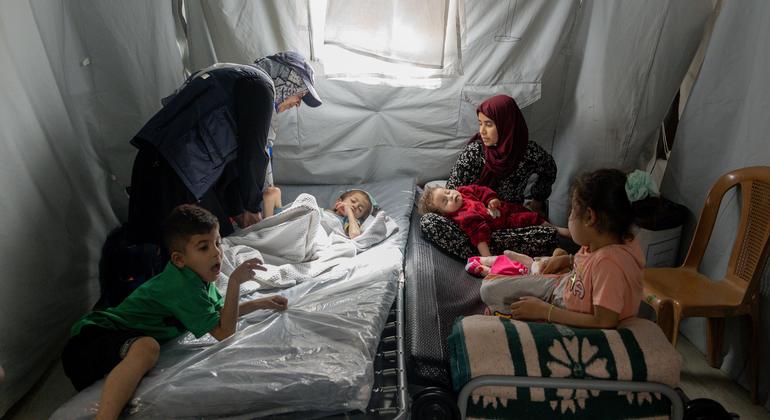Doctors in Gaza struggling to face ‘overwhelming disaster’ as essential supplies run out: WHO

“We have distributed a large amount of essential medical supplies but it is still not enough. I mean, This is a terrible disaster, it’s not enough,” Dr. Rik Peeperkorn, United Nations World Health Organization (WHO) represented in Palestine.
Speaking in Geneva on the sidelines of the World Health Conference, the senior WHO official echoed the international community’s widespread condemnation of an Israeli air strike on a camp for displaced people in Tal as -Sultan, northwest of Rafah, left several people dead on Sunday.
“WHO sincerely regrets the attack on displaced people. It proves that there is no safe place in Gaza,” he said. UN NewsEQUAL Video of field hospital treating victims distributed by the United Nations aid office, OCHAshows an injured father crying as he describes the moment his children died.
“When the strike happened, I was thinking about my children,” said Mohammad Al Ghouf. “I promised them I would go to the supermarket, shop and hug them. But unfortunately, I am here, and they are somewhere else.”
From the same OCHA footage filmed on Monday, the medical director of the International Medical Corps (IMC) field hospital described the grim task of preparing lifeless victims for burial.
“I saw the body of a father holding his child, probably about three years old. They were burned and charred. We cannot separate them. Therefore, We had to put both of them in a body bag. It was very, very difficult.”
Lack of burn care
About 75 patients were treated at the IMC field hospital.
“Of those 75 people, 25 are very critical,” the IMC official added, raising deep concerns that doctors specializing in burns, trauma care and medicine they needs have been out of reach in Gaza since the Israeli army seized the main aid crossing point at Rafah earlier. this month.
“There’s only so much you can do in Gaza. And when it comes to really extensive burns and so on, there is currently no place in Gaza where it can be treated,” Dr. Peeperkorn said. “Since the closure of the Rafah border gate, we have only had three trucks entering Rafah. They come from Kerem Shalom and that is the only source of supply. Luckily, we still have some supplies left, but they’re running out.”
WHO officials emphasized that the dangerous shortage of life-saving aid supplies could be overcome if trucks carrying humanitarian aid were allowed to return to the area in significant numbers.
Aid obstacles remain
“There are 60 WHO trucks standing in El Arish [in Egypt] ready to enter Gaza. So again, this call: the Rafah border crossing needs to be opened not only for medical supplies but also for all other humanitarian supplies,he say.
“We have distributed a large amount of essential emergency medical supplies, but it is still not enough. This is truly a terrible disaster. Now, when there is a sustained ceasefire and there are properly managed routes into Gaza, when there is a deconfliction mechanism that actually facilitates and supports, then many things can be done. get more.”
The United Nations health agency has previously warned that more Gazans will die unless desperately needed medical evacuations of seriously ill or injured people are allowed outside the area. A further 10,000 people are said to need urgent transport outside Gaza for treatment, but since Rafah closed on May 6, “there have been no medical evacuations outside of Gaza and this has been a major problem before.””, Dr. Peeperkorn said.
More than a million people had to leave their homes
According to the United Nations agency for Palestinian refugees, UNRWAand OCHA, increased hostilities and evacuation orders have displaced more than 940,000 people from Rafah in the past three weeks along with 100,000 displaced people in northern Gaza.
“Attacks on Rafah continue unabated and civilians displaced by the conflict lack shelter, food, water as well as supplies and services,” OCHA said in an update Tuesday. other services necessary for their survival..
The same update said Gazan medical facilities continue to face severe shortages of fuel and medical supplies “while dealing with increasing casualties from injuries and burns ”. OCHA noted that Nasser Medical Group also urged people to donate blood.
The humanitarian update reiterated long-standing concerns about the lack of aid reaching Gaza and emphasized that although Kerem Shalom intersection “remains open in principle, aid organizations are extremely difficult to access from the Gaza side due to hostility, challenging logistical conditions and complex coordination procedures…access restrictions continue to hinder the delivery of humanitarian aid save people inside Gaza.”
From May 1 to 26, OCHA reported that only 137 humanitarian aid missions were facilitated by Israeli authorities to areas requiring coordination across Gaza; 86 were “obstructed after the green light was given or were denied access in the first place, and 43 were canceled by the organisers”.
Compulsory treatment
Amid the ongoing devastation caused by nearly eight months of war in Gaza that began in response to Hamas-led terrorist attacks in southern Israel, WHO officials stressed the need to support reconstruction. build Gaza’s largely destroyed health system into the future to help the region recover and recover. support a sustainable peace.
“When you start thinking about early healing, recovery and reconstruction, we need to think completely differently about bringing goods into Gaza, including, of course, medical and specific medical,” Dr. Peeperkorn said, emphasizing the historical difficulties involved in introducing standard medical equipment.
“It took us almost two years to get three mobile X-ray machines. Every referral hospital anywhere in the world has some of these mobile X-ray machines; they are introduced almost everywhere. So it’s complete nonsense and I just want to emphasize this point, we all hope there will be a lasting ceasefire soon,” he said.

Dr. Rik Peeperkorn, director of the WHO office in the West Bank and Gaza, was interviewed by UN News.
“We must also look to the future, we must push for a lasting ceasefire and then…soon recovery, a recovery process (should) start as soon as possible. There needs to be a solution for the Palestinians,” the WHO official continued, noting that Gaza still has “a lot of very capable medical professionals,” many working as volunteers, who “should be the heart and center” of the reconstruction and recovery process.




